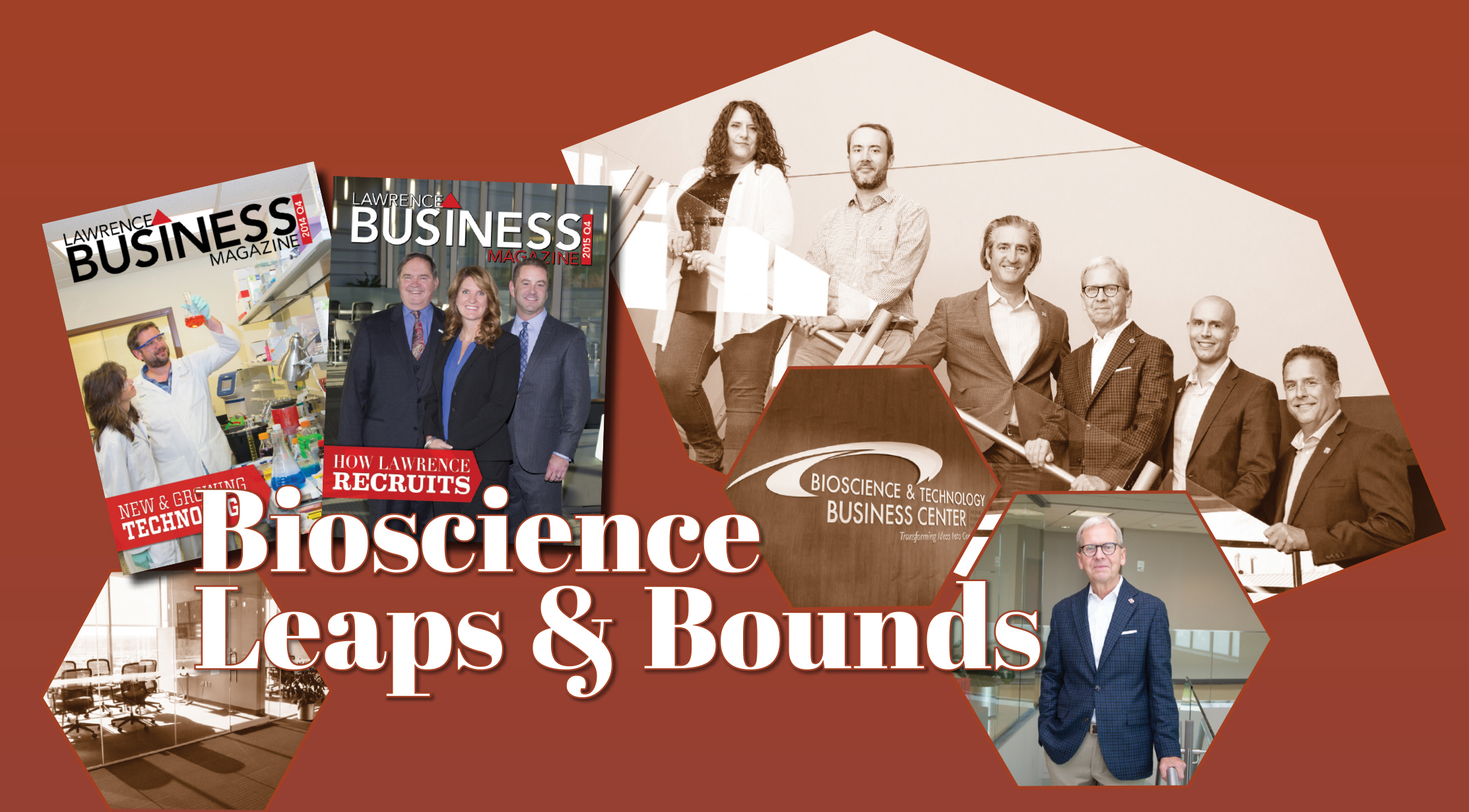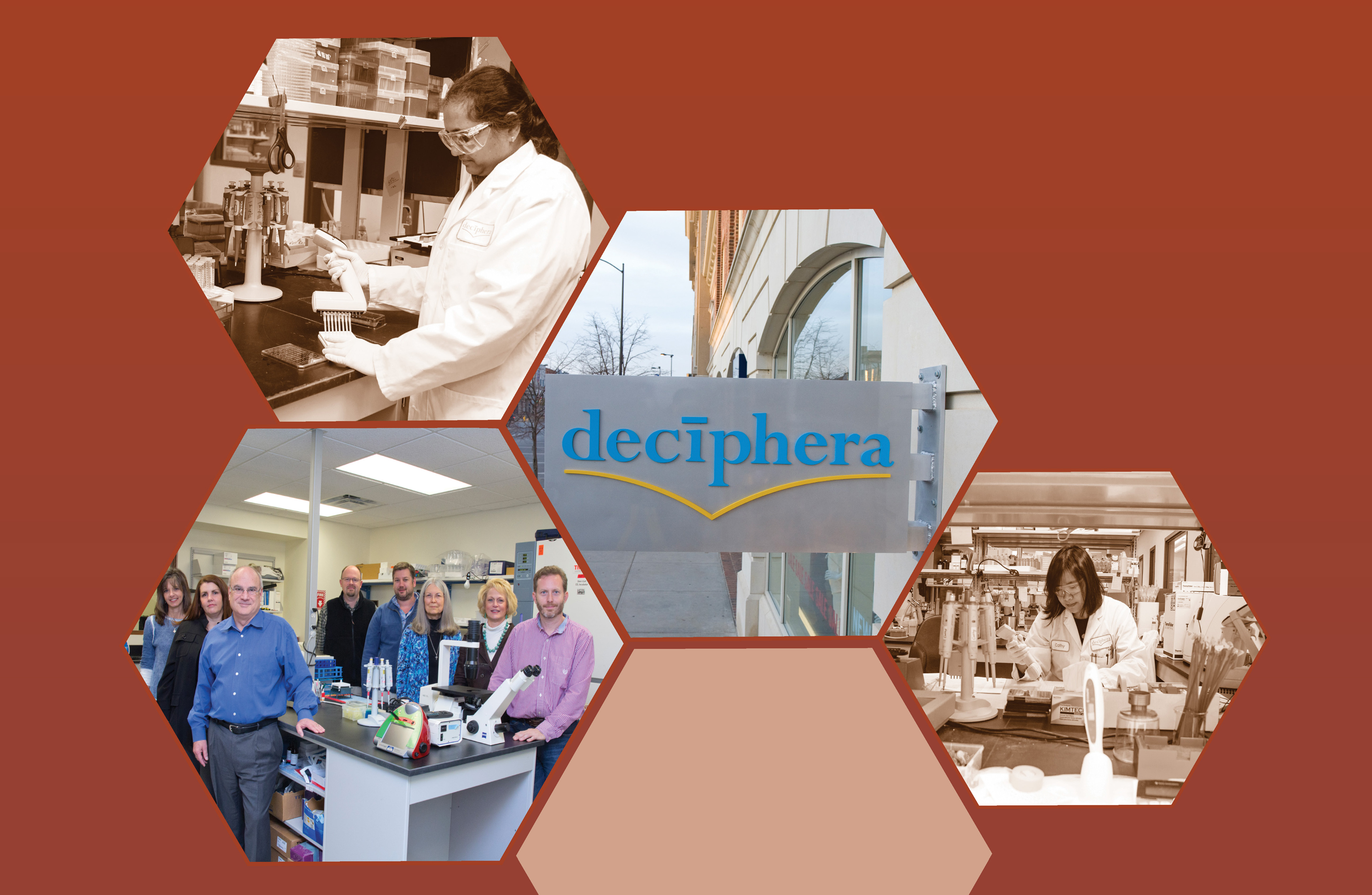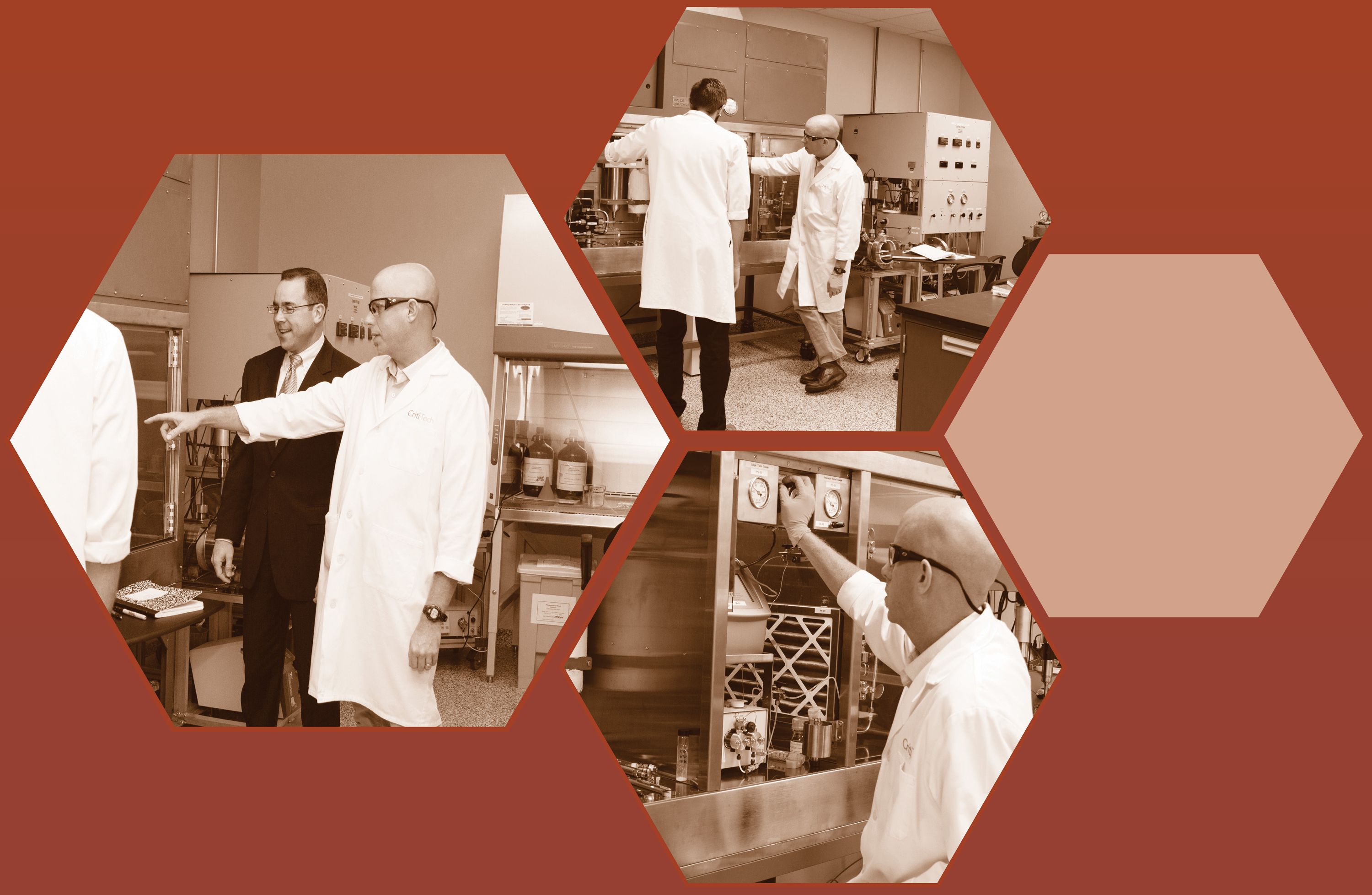| story by | |
| photos by | Steven Hertzog |
| OPEN A PDF OF THE ARTICLE |
BTBC pharmaceutical companies continue to make advancements in technology and biosciences, and are confident the next 10 years will far exceed the last.
It’s long been believed that, according to laws of accelerating returns, the pace of technological progress throughout the world increases exponentially as time passes because of common forces driving it forward. After all, technology is an evolutionary process, and being exponential, it’s widely believed, is all about evolution.
So it has been for technological and scientific advancements over the last decade or so in the Lawrence area. The proof lies in the leaps forward by three local companies/organizations that have made great technological strides and meaningful advancements in the areas of biosciences and pharmaceuticals.
The Bioscience and Technology Business Center, located on the University of Kansas West Campus and an incubator for entrepreneurial start-up companies in the bioscience and tech realms, has more than doubled its tenant companies and more than quadrupled aggregate payroll since launching around 2010. During the next 15 years, it plans on adding 600,000 to 800,000 square feet of space in a new KU Innovation Park that will rival any such facility in the country.
Deciphera Pharmaceuticals, a downtown Lawrence company that develops cancer-fighting drugs using kinase inhibitors, received approval by the U.S. Food and Drug Administration in mid-2020 for its first medication, QINLOCK, for the treatment of patients with gastrointestinal stromal tumors. Deciphera has three additional oncology drugs currently in clinical trials, including Vimseltinib, Rebastinib and DCC-3116. The company has multiple research programs in its pipeline for the next wave of cancer-fighting drugs in the years to come.
CritiTech Particle Engineering Solutions, which largely works with existing drugs to make them more efficiently absorbed and delivered in the body, also has a number of cancer-fighting drugs in development, two of which are in clinical trials. In recent years, the company has constructed and developed facilities in North Lawrence, which continue to grow and are expected to expand through the next decade.
Even a worldwide COVID-19 pandemic that shut down much of the world economy couldn’t slow the Goliath that is technology and biosciences.
“We had a couple of companies that didn’t make it during COVID,” says LaVerne Epp, executive chairman of the Bioscience and Technology Business Center. “But we had others that rebounded strongly. The last two quarters were probably the most robust we’ve had. A combination of pent-up demand and new product delivery … opened new markets for sure.
“Companies that are innovative took advantage of the opportunities,” he adds.

LBM Covers, New and Growing Technology (2014Q4) and How Lawrence Recruits (2015Q4); E. LaVerne Epp, Executive Chairman of KU Innovative Park (formerly BTBC) with staff
An Unbeatable Collaboration
The Bioscience and Technology Business Center (BTBC) is an enterprise with a unique combination of four stakeholders: the City of Lawrence, Douglas County, Lawrence Chamber of Commerce and KU. Each stakeholder has equal shares and a position on the governing board. However, the BTBC operates independently from those stakeholders.
“Whatever success the BTBC has had, it’s been because of this unique collaboration of government, city and university,” Epp says. “All are committed to the primary focus of the organization. The whole intent was to get these four entities to collaborate in helping the local economy.”
What the BTBC essentially does is provide resources, in the forms of workspace, creative and intellectual consultation, and other resources, to start-up companies looking for help. In 2014, the BTBC had under its collective roof in its original West Campus facility 27 companies, 130 employees and an aggregate payroll of $6 million.
Today, there are 62 companies in the BTBC system. They account for 450 jobs and an aggregate payroll of around $27 million. The BTBC also added a couple locations: an expansion facility at Wakarusa Drive and Bob Billings Parkway, and a facility at the KU Medical Center in Kansas City, Kansas.
“We didn’t anticipate demand,” Epp says. “Within 18 months (of opening the original facility in 2010), we had filled all the space in the original building.”
That demand and need for more space has only continued to grow over the years. In the past 12 months, Epp explains, the BTBC’s board and management team decided to change the organization’s name and embark on a new, aggressive growth strategy.
KU Innovation Park was effectively launched. That immediately involves an extension/expansion of the West Campus facility, creating more workspace for existing companies and more opportunities for more start-ups. It evolves by 2036 into construction of eight to 10 new buildings accommodating 72 to 85 larger companies, as well as current companies’ growth.
“The number of jobs created will be more robust than ever,” says Epp, who anticipates 2,000 to 2,500 jobs and a $120- to $150-million payroll, 3 to 3½ percent of Lawrence’s total economy.
“We’re very intentional about creating a more diverse and robust economy for Lawrence,” he continues. “An environment that is more sustainable and resilient.
“We really care about these businesses,” Epp adds. “We want them all to succeed.”

Deciphera Pharmaceuticals (2014Q & 2019Q4)
Fighting Cancer by Inhibiting Kinases
Daniel Flynn founded Deciphera Pharmaceuticals in 2003. Through his vast clinical research, he and his colleagues discovered that many cancers were driven by mutations or overexpression in kinases. Kinases are proteins that serve as a circuit board of sorts for communications and regulation of cell activity.
There are more than 521 human kinases, and each must remain in control of its shape for a body’s cells to remain healthy.
“Each kinase has a switch control mechanism which regulates their on and off shapes,” says Flynn, executive vice president and chief scientific officer. “In many cases, these switch controls are broken through acquired mutations, and the shape, or switch, of these kinases are dysregulated, resulting in uncontrolled signaling.
“We’ve made big strides in the last 10 years understanding kinase switch control mechanisms,” he says.
Flynn explains that Deciphera has used a technology called Xray crystallography to capture atomic-level pictures of switch control mechanisms in kinases and use these pictures to design their switch control kinase inhibitors.
“In essence, what our drugs are doing is binding into cancer-causing kinases and shutting down the on switch,” he says. “It’s not chemotherapy but targeted therapeutics which hone in on the molecular cause of cancer.”
FDA-approved QINLOCK has proven it can improve overall survival rates in patients with gastrointestinal stromal tumors (GIST) for more than a year.
A second Deciphera medication, Rebastinib, is in Phase 2 clinical trials for the treatment of ovarian cancer. Other drugs in the pipeline include Vimseltinib, which treats patients with tumors in joints that hit early in life, and a yet-unnamed product, DCC-3116, which treats cancers caused by RAS/RAF mutations, the most common activating mutations of all cancers. RAS mutations are a primary mutational cause of cancers with significant unmet medical need, including pancreatic cancer, lung cancer, colorectal cancer and melanoma.
Flynn says Deciphera is in the midst of doubling its research facility, which takes up half a block between Sixth and Seventh streets on Massachusetts Street, including expanded lab space and office space for the research site’s 60 employees. The company’s corporate office is in Boston, and Flynn says it recently established an international headquarters in Switzerland.
Deciphera had its initial public offering in 2017 and is now traded on NASDAQ
“It’s exciting times for us,” Flynn says. “In the next 10 years, we hope to have multiple drugs on the market and an even more robust research engine. Creating drugs that will keep cancer in check or eradicate it, so that patients have years of quality live … that is my mantra.”

Crititech President Mathew McClorey, in suit and tie, dis-cussing new technology with his lab partners (2014Q4)
Improving Existing Medications, Creating New Ones
CritiTech was founded in 1997 around a proprietary technology called Supercritical Precipitation. The technology addresses solubility issues with new and existing drugs, or the ability of a medication to be absorbed efficiently into the body and delivered to the area of need. A key feature of the Supernatural Precipitation technology is the ability to engineer drug particles large enough to stay in a diseased area but also possess a greatly enhanced surface area that enables the drug to dissolve at a rate sufficient to effectively treat the disease or condition, improving patient outcomes from both a safety and efficacy standpoint.
“We spent the last decade in large part refining the Supercritical Precipitation technology so it can produce drugs on a commercial scale,” says Matthew McClorey, president of CritiTech.
Engineering and constructing commercial manufacturing equipment that utilizes the Supercritical Precipitation technology was a major breakthrough for the company. Once that occurred, CritiTech began expanding its drug production facilities in North Lawrence.
“Establishing our manufacturing facilities in North Lawrence has been critical to our growth,” McClorey says. “It’s one thing to have the technology. It’s another to scale it up.”
CritiTech partnered with NanOlogy, a clinical-stage oncology company, which is developing four cancer drugs with the Supercritical Precipitation technology. NanOlogy has completed or is in the process of completing eight Phase 2 trials using NanoPac and NanoDoce to treat various cancers, including pancreatic cancer, prostate cancer, ovarian cancer, pancreatic cysts, bladder cancer, lung cancer and cutaneous metastasis.
“NanOlogy’s drugs have performed well in the clinic, demonstrating excellent safety and generating positive efficacy data,” McClorey says.
A primary goal moving forward for CritiTech, which has 16 employees, is continuing working with NanOlogy to advance its oncology drugs through clinical trials and into the marketplace, he continues. The company also has started a respiratory drug development program that is using the Supercritical Precipitation technology to engineer particles that are ideal for direct delivery into the lungs, particles that result in much higher concentrations and longer retention times in the lungs that can be achieved with standard of care drugs.
Supercritical Precipitation is a platform for developing drugs for direct injection into solid tumors, direct delivery into the lungs for treating respiratory diseases and conditions, and direct delivery for the localized treatment of pain and infection in tissues.
“In the future, I believe drugs will become increasingly much more customized and tailored to certain patients,” McClorey says. “I think treatments will be much more targeted with more precision.”
One thing seems certain. When it comes to working in the areas of biosciences and technology, whether it’s the Bioscience and Technology Business Center, Deciphera Pharmaceuticals or CritiTech Particle Engineering Solutions, advancements and improvements in what they do promise to move much more quickly in the next 10 years than they did the last. These companies wouldn’t have it any other way.
![]()





